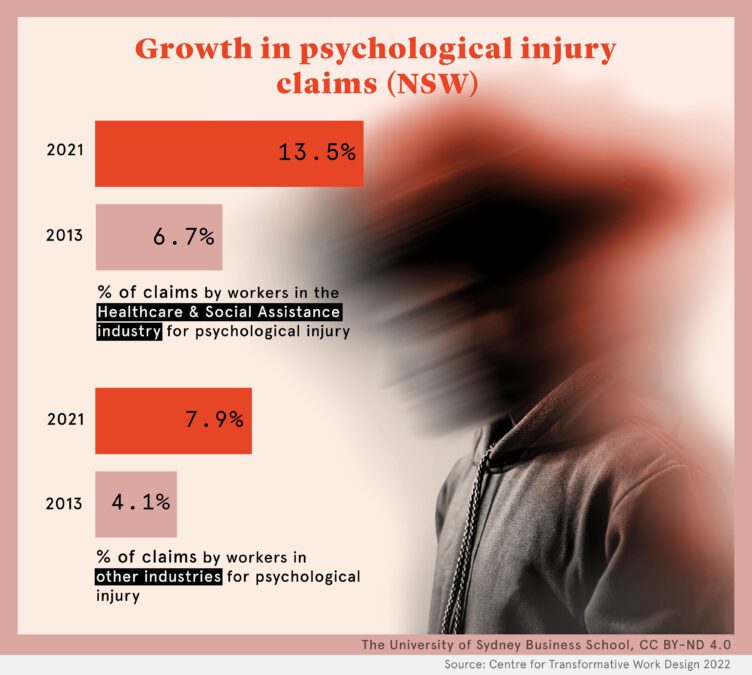Anya Johnson and Helena NguyenAnya Johnson, Helena Nguyen,
text

SDGs by 2030 – are we on track?
Caring for the carers
The world’s health challenges are enormous. Ancient diseases such as Malaria and Tuberculosis continue to kill and debilitate millions of people every year and a new pathogen could, once more, shut down the world. While a future pandemic is a ‘known unknown’, COVID-19 demonstrated that a healthy workplace is vital to the smooth running of a nation’s healthcare system.
It’s not difficult to describe what a good healthcare sector looks like: we often get distracted by the bricks and mortar and the technology, but ultimately what matters is a workforce that provides the quality care you want for yourself and the people you love.
We are interested in how a society can keep its health workforce healthy.

Even a developed country like Australia has areas experiencing staffing crisis: overcrowded emergency departments, bed closures in rural areas, gaps in community care and in general practice.
How can we best create and sustain this vital workforce? A good start is a robust training program for junior healthcare professionals. This is not just a call for better ‘formal’ training, we also need high-quality social modelling demonstrating effective ways of managing emotions and challenging situations.
Professionals in the care giving sector must grasp the profound impact of emotional norms on their own and others’ emotional regulation. It is crucial for them to cultivate a keen awareness of their own emotions and role in fostering compassion within their workplace. A pivotal factor is creating a workplace system and culture where all staff, including junior professionals, feel empowered and safe to advocate confidently for patients and colleagues whenever they witness errors or misconduct among senior colleagues.
Once these valuable professionals are trained, it’s imperative to establish a supportive system that retains them in healthcare, preventing them from becoming yet another statistic in the unacceptably high burnout rates pervasive in the healthcare and social assistance sectors. These rates are not only depleting essential skills but also creating imbalances and risks in terms of patient-to-staff ratios across hospitals and residential aged care facilities.
Yes, it’s about improving pay rates. But, while pay is part of the solution, it is not the whole solution.
Our research shows the quality and design of work and the social capital that is created within teams is also important in retaining healthcare professionals and allowing them to flourish whilst undertaking their life saving tasks. We need to redesign work to create better work and support systems for all healthcare professionals. The system relies on responsible healthcare leaders who are courageous, supportive, build trust and empower team members. High performance teams are those that are psychologically safe, diverse, collaborative and inclusive.
Hospitals with high rates of workforce bullying also have low rates of staff engagement. Stressed health units, for example, record significantly higher rates of hospital-acquired infections. Lack of proper handwashing, poor adherence to infection control procedures are problems that exist where there is poor leadership and bad workplace design. Eventually it’s the patients and their families who suffer the consequences.
Governments prefer to spend money on patient care – assuming this offers more bang for their political buck. We need to shift that mindset so that supporting the workforce is seen as a politically and economically smart decision. Healthcare budgets need dollar targets for workforce support.
Increasingly virtual team members are becoming an intrinsic part of the healthcare ‘workforce’. AI is increasingly being used to analyse symptoms, read scans, come up with a diagnosis. But devising the best treatment plan and supporting patients to follow it will still be in the control of the humans in the healthcare team. We want a system that better supports our healthcare professionals to be the best advocate for the patients in their care.

Sustainable Development Goal (SDG) target addressed:
3.c Substantially increase health financing and the recruitment, development, training and retention of the health workforce in developing countries, especially in least developed countries and small island developing States.
Resources
Student assignment
Research the engagement scores for the hospitals in a particular area/country – and explore how they are linked to other hospital data.
How would you train team members to speak up and voice their concerns in a situation where they had observed a mistake on the part of a more senior colleague?
Further reading
Articles
- Nguyen, H., Groth, M., & Johnson, A. (2023) How display rules influence turnover in healthcare teams and the moderating role of team negative affective tone. Journal of Service Research.
- Choi, E., Leroy, H., Johnson, A. & Nguyen, H. (2022) Flaws and All: How Mindfulness Reduces Error Hiding by Enhancing Authentic Functioning. Journal of Occupational Health Psychology. 27(5), 451–469.
- Johnson, A., Nguyen, H., Groth, M. & White, L. (2018) Reaping the rewards of functional diversity in healthcare teams: Why team processes improve performance. Group & Organization Management. 43 (3), 440-474.
- Johnson, A., Nguyen H., & Groth (2018). Workplace Aggression and Organisational Effectiveness: The Mediating Role of Employee Engagement. Australian Journal of Management 43 (4), 614-631.
- Johnson, A., Nguyen, H., Parker, S. K., Groth, M., Coote, S., Perry, L., & Way, B. (2017). “That was a good shift”: interprofessional collaboration and junior doctors’ learning and development on overtime shifts. Journal of Health Organization and Management, 31, 471 – 486.
- Nguyen, H., Groth, M., & Johnson, A. (2016). When the going gets tough, the tough keep going to work: The Impact of Emotional Labor on Employee absenteeism Journal of Management. vol.42:3, pp. 615-43.
- Parker, S. K., Johnson, A., Collins, C., & Nguyen, H. (2013). Making the Most of Structural Support : Moderating Influence of Employees’ Clarity and Negative Affect. Academy of Management Journal. 56(3) 867-892.
- Wang, K., de Montemas, W., Dey, S. Johnson, A,, Nguyen, H. Tuqiri, K. Crawford, B. and Murray, S. (2024) “Not just a “nice to have”: Team compassionate care behaviours and patient safety”. Australian Journal of Management.
- Zettna, N., Nguyen, H., Restubog, S., Schilpzand, P., & Johnson, A. (2024). How Teams Can Overcome Silence: The Roles of Humble Leadership and Team Commitment. Personnel Psychology.
- Zettna, N., Yam, C., Kunzelmann, A., Forner, V., Dey, S., Askovic, M., Johnson, A., Nguyen, H., Jolly, A., & Parker, S. K. (2024). Crystal Clear: How Leaders and Coworkers Together Shape Role Clarity and Well-Being for Employees in Social Care. Human Resource Management.
Podcast
Websites
- Centre for Transformative Work Design: Design for Care
- The University of Sydney: Business Research – Body, Heart and Mind in Business Research Group
Reports
- Gelaw, A., Sheehan, L., Gray, S. and Collie, A. “Psychological injury in the New South Wales Healthcare and Social Assistance industry: A retrospective cohort study“. Healthy Working Lives Research Group, School of Public Health and Preventive Medicine, Monash University (2022).
Anya is a Professor and Head of the Discipline of Work and Organisational Studies and Co-Director of the Body, Heart and Mind in Business Research Group at the University of Sydney Business School. Her research mainly investigates how employees regulate their emotions and cognitions in the workplace, and the relationship between the design of jobs and teams and outcomes such as engagement, well-being, and performance.
Helena is a Professor in Work and Organisational Studies and Co-Director of the Body, Heart and Mind in Business Research Group at the University of Sydney Business School. Her research is multidisciplinary and her interests include the role of emotions and cognition at work, human performance, work engagement, and well-being.
Share
We believe in open and honest access to knowledge. We use a Creative Commons Attribution NoDerivatives licence for our articles and podcasts, so you can republish them for free, online or in print.



